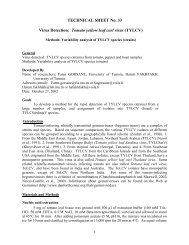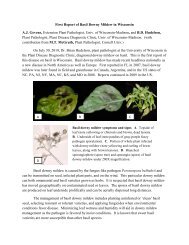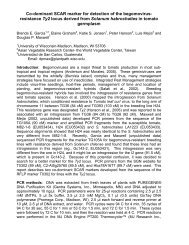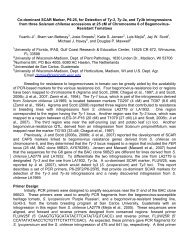Fungicide Updates in Onion - Department of Plant Pathology
Fungicide Updates in Onion - Department of Plant Pathology
Fungicide Updates in Onion - Department of Plant Pathology
You also want an ePaper? Increase the reach of your titles
YUMPU automatically turns print PDFs into web optimized ePapers that Google loves.
<strong>Fungicide</strong> <strong>Updates</strong> <strong>in</strong> <strong>Onion</strong><br />
Amanda Gevens<br />
Extension <strong>Plant</strong> Pathologist<br />
University <strong>of</strong> Wiscons<strong>in</strong>-Madison<br />
Orig<strong>in</strong>ally presented at the WPVGA Ed<br />
Conference Feb 2, 2011<br />
Stevens Po<strong>in</strong>t, WI – 11:15-11:45AM<br />
-content updated July 12, 2012
Common <strong>Onion</strong> Diseases <strong>in</strong> WI<br />
Botrytis Neck Rot<br />
Botrytis allii<br />
Botrytis Leaf Blight<br />
Botrytis squamosa<br />
Purple Blotch<br />
Alternaria porri<br />
Downy Mildew<br />
Peronospora destructor<br />
Bacterial Rots<br />
Pseudomonas and<br />
Pectobacterium spp.
Botrytis Neck Rot<br />
omafra<br />
sherf<br />
•Common disease <strong>in</strong> stored onions with previous <strong>in</strong>jury<br />
•Favored by cool, wet conditions and poor dry<strong>in</strong>g and cur<strong>in</strong>g <strong>of</strong> onions<br />
•Infected bulbs rot <strong>in</strong> storage<br />
•<strong>Fungicide</strong>s are generally <strong>in</strong>effective for neck rot control
Botrytis Leaf Blight<br />
•Widespread fungal disease <strong>of</strong> onion<br />
•Favored by warm, humid weather – mid to late season<br />
•Causes blight<strong>in</strong>g and early death <strong>of</strong> leaves, undersized bulbs, low yield<br />
•<strong>Fungicide</strong>s can control Botrytis leaf blight
Purple Blotch<br />
wikia<br />
•Common <strong>in</strong> many US onion-grow<strong>in</strong>g regions – overw<strong>in</strong>ters <strong>in</strong> residue<br />
•Promoted by long periods <strong>of</strong> ra<strong>in</strong> or heavy dew<br />
•Often seen with other fungal diseases<br />
•<strong>Fungicide</strong>s can control Purple blotch
Downy Mildew<br />
•Serious yet sporadic disease<br />
•Driven by cool, moist conditions<br />
•Causes blight<strong>in</strong>g and early death <strong>of</strong> leaves, undersized bulbs, low<br />
yield, poor storability<br />
•<strong>Fungicide</strong>s can control Downy mildew
Bacterial Rots<br />
•Widespread and destructive storage disease <strong>of</strong> onions<br />
•Initiated right before or at harvest <strong>of</strong> bulbs<br />
•Bacteria reside <strong>in</strong> soil and plant debris – maggots can spread disease<br />
•Infection typically occurs after plant becomes wounded (hail damage)<br />
or leaves senesce<br />
•Disease favored by warm and wet conditions<br />
•Copper-conta<strong>in</strong><strong>in</strong>g fungicides applied quickly after ra<strong>in</strong>/hail event can<br />
aid <strong>in</strong> cur<strong>in</strong>g <strong>of</strong> wounds and limit bacterial <strong>in</strong>fection
Bacterial Rots<br />
•Management options <strong>in</strong>clude cultural and chemical methods<br />
•M<strong>in</strong>imize <strong>in</strong>jury to matur<strong>in</strong>g and harvested bulbs<br />
•Harvest bulbs after necks are appropriately dried<br />
•Dry onions thoroughly before storage, and store at temp <strong>of</strong> 32-<br />
33°F and at >70%RH with good ventilation<br />
•Avoid highly susceptible varieties such as Spanish sweet<br />
types - there are no resistant varieties<br />
•Control <strong>in</strong>sects such as maggots<br />
•Copper-conta<strong>in</strong><strong>in</strong>g fungicides applied quickly after ra<strong>in</strong>/hail<br />
event can aid <strong>in</strong> cur<strong>in</strong>g <strong>of</strong> wounds and limit bacterial <strong>in</strong>fection<br />
•Copper-conta<strong>in</strong><strong>in</strong>g fungicides are <strong>in</strong>effective if applied after<br />
symptoms develop
Best Cultural Management Practices<br />
For <strong>Onion</strong> Diseases <strong>in</strong> WI<br />
•<strong>Plant</strong> disease-free seedl<strong>in</strong>gs or sets<br />
•Do not plant >0.25 <strong>in</strong>ch below soil surface<br />
•Rotate crops (out <strong>of</strong> Alliaceae family) for 2-3 years<br />
•Scout regularly for early signs <strong>of</strong> pest/disorder<br />
•Destroy volunteers or cull onions to reduce pathogen<br />
•Field sanitation – remove onion debris<br />
•Avoid late season N application<br />
•Avoid harvest <strong>in</strong>juries, harvest mature bulbs with a few<br />
<strong>in</strong>ches <strong>of</strong> neck rema<strong>in</strong><strong>in</strong>g, and harvest <strong>in</strong> dry weather<br />
•Proper dry<strong>in</strong>g conditions prior to storage (~90°F for >5 days)
<strong>Onion</strong> <strong>Fungicide</strong>s<br />
•When fungicides are needed, apply effective<br />
materials, provid<strong>in</strong>g good coverage, at appropriate<br />
times<br />
•Excessive ra<strong>in</strong>fall promotes many diseases and<br />
<strong>in</strong>terferes with tim<strong>in</strong>g and persistence <strong>of</strong> fungicides<br />
•With currently >50 fungicides registered for use on<br />
onions <strong>in</strong> WI, selection <strong>of</strong> appropriate materials can<br />
be confus<strong>in</strong>g
•Use chlorothalonil judiciously,
<strong>Fungicide</strong><br />
trade name<br />
Bravo, Echo,<br />
Equus, Initiate<br />
Dithane,<br />
Manzate,<br />
Penncozeb<br />
Kocide, Champ<br />
Formula II,<br />
Champion<br />
Quadris, Cabrio,<br />
Reason, Prist<strong>in</strong>e<br />
<strong>Fungicide</strong><br />
active<br />
<strong>in</strong>gredient<br />
Botrytis leaf<br />
blight<br />
Purple blotch<br />
Downy<br />
mildew<br />
Bacterial rots<br />
chlorothalonil Good Good Modest -<br />
mancozeb Good Good Excellent -<br />
coppers Modest Modest Modest Good<br />
azoxystrob<strong>in</strong>,<br />
pyraclostrob<strong>in</strong>,<br />
fenamidone,<br />
pyraclostrob<strong>in</strong> +<br />
boscalid<br />
Excellent Excellent Excellent -<br />
Ridomil mefenoxam - - Excellent -<br />
Scala pyrimethanil Excellent Excellent - -<br />
Rovral, Iprodione iprodione Excellent Excellent Good -<br />
Switch cyprod<strong>in</strong>il +<br />
fludioxonil<br />
Excellent Excellent Excellent -<br />
Omega fluaz<strong>in</strong>am Excellent Excellent Modest -<br />
Forum dimethomorph - - Excellent -<br />
Aliette fosetyl-al - - Excellent -
Comments on the Performance <strong>of</strong> Other or<br />
Newly Registered <strong>Onion</strong> <strong>Fungicide</strong>s<br />
Very effective at controll<strong>in</strong>g downy<br />
mildew: Quadris Top<br />
(azoxystrob<strong>in</strong>+difenoconazole), Inspire<br />
Super (cyprod<strong>in</strong>il+difenoconazole), Revus<br />
(mandipropamid)<br />
Effective at controll<strong>in</strong>g purple blotch:<br />
Folicur (& other trade names), Endura<br />
(also effective on Botrytis leaf blight)<br />
Varied disease control performance with:<br />
Tanos and Ranman
<strong>Fungicide</strong> Active <strong>in</strong>gredient <strong>Fungicide</strong> Resistance Action<br />
Committee code (FRAC)<br />
Dithane DF Ra<strong>in</strong>shield, Dithane F45<br />
mancozeb<br />
M3<br />
Ra<strong>in</strong>shield, Dithane M45, Manzate, Manzate<br />
Pro-Stick <strong>Fungicide</strong>, Penncozeb 4FL, 75DF,<br />
80WP<br />
Bravo Zn, Echo Zn, Bravo WeatherStik, chlorothalonil<br />
M5<br />
Bravo Ultrex, Chloronil 720, Echo 720, Echo<br />
90DF, Chlorothalonil 720SC, Equus 500 Zn,<br />
Initiate Zn, Equus 720 SST, Initiate 720,<br />
Equus DF<br />
Badge SC copper hydroxide + copper oxychloride M1<br />
C-O-C-S WDG copper oxychloride sulfate M1<br />
Champ DP Dry Prill, Champ WG, Champ copper hydroxide<br />
M1<br />
Formula 2 Flowable, Champion WP, Kocide<br />
2000, Kocide 3000, Kocide DF, Kentan DF,<br />
Nu-Cop 3L, Nu-Cop 50DF<br />
Copper-Count-N copper ammonium complex M1<br />
Cueva copper octanoate M1<br />
Cupr<strong>of</strong>ix Ultra 40 Disperss basic copper sulfate M1<br />
Nordox, Nordox 75WG cuprous oxide M1<br />
Cupr<strong>of</strong>ix MZ Disperss basic copper sulfate + mancozeb M1 + M3<br />
Mankocide copper hydroxide + mancozeb M1 + M3
<strong>Fungicide</strong> Active <strong>in</strong>gredient <strong>Fungicide</strong> Resistance Action<br />
Committee code (FRAC)<br />
MicroSulf, Micr<strong>of</strong><strong>in</strong>e sulfur, Microthiol<br />
Disperss, Kumulus DF, Super-Six<br />
Thiophanate Methyl 85-WDG, Tops<strong>in</strong> 4.5FL,<br />
Tops<strong>in</strong> M 70WDG, Tops<strong>in</strong> M 70WP, Tops<strong>in</strong> M<br />
WSB, Tops<strong>in</strong> 4.5FL, T-Methyl 70W WSB, T-<br />
Methyl E-AG 4.5F, Incognito 4.5F, Onset<br />
Iprodione 4L Ag <strong>Fungicide</strong>, Rovral 4<br />
Flowable <strong>Fungicide</strong>, Nevado 4F<br />
Folicur 3.6F, Tebuzol 3.6F, Toledo,<br />
Monsoon, Orius 3.6F, Tebustar 3.6L<br />
Propiconazole E-AG 41.8 EC, Propimax EC,<br />
Tilt, Bumper 41.8EC, Topaz<br />
sulfur<br />
thiophanate-methyl 1<br />
iprodione 2<br />
tebuconazole 3<br />
propiconazole 3<br />
Metastar 2E AG, Allegiance, Sebr<strong>in</strong>g 2.65ST metalaxyl 4<br />
Ridomil Gold EC, Ridomil Gold SL, Ultra<br />
Flourish, Apron XL<br />
mefenoxam 4<br />
Endura boscalid 7<br />
M2<br />
Fontelis penthiopyrad 7<br />
Scala SC pyrimethanil 9<br />
Vangard WG cyprod<strong>in</strong>il 9<br />
Cabrio EG pyraclostrob<strong>in</strong> 11<br />
Dynasty, Heritage, Quadris azoxystrob<strong>in</strong> 11<br />
Reason 500SC fenamidone 11
<strong>Fungicide</strong> Active <strong>in</strong>gredient <strong>Fungicide</strong> Resistance Action<br />
Committee code (FRAC)<br />
Maxim 4FS fludioxonil 12<br />
Botran 75W DCNA Dichloran 14<br />
Actigard 50WG acibenzolar s-methyl 21<br />
Omega 500f fluaz<strong>in</strong>am 29<br />
Aliette, Lesion 80 WDG, L<strong>in</strong>ebacker WDG fosetyl-al 33<br />
Phostrol phosphorous acids 33<br />
Fosphite, FungiPhite, ProPhyt, Alude,<br />
Rampart<br />
potassium phosphite 33<br />
Phorcephite potassium phosphate, potassium phosphite 33<br />
Forum dimethomorph 40<br />
Revus mandipropamid 40<br />
Quadris Top azoxystrob<strong>in</strong> + difenoconazole 11 + 3<br />
Quilt Excel azoxystrob<strong>in</strong> + propiconazole 11 + 3
<strong>Fungicide</strong> Active <strong>in</strong>gredient <strong>Fungicide</strong> Resistance Action<br />
Committee code (FRAC)<br />
Quadris Opti axoxystrob<strong>in</strong> + chlorothalonil 11 + M5<br />
Tanos cymoxanil + famoxadone 27 + 11<br />
Ridomil Gold Copper mefenoxam + copper hydroxide 4 + M1<br />
Ridomil Gold MZ WG mefenoxam + mancozeb 4 + M3<br />
Ridomil Gold Bravo SC chlorothalonil + mefenoxam 4 + M5<br />
Quadris Opti axoxystrob<strong>in</strong> + chlorothalonil 11 + M5<br />
Prist<strong>in</strong>e boscalid + pyraclostrob<strong>in</strong> 7 + 11<br />
Switch 62.5WG cyprod<strong>in</strong>il + fludioxonil 9 + 12<br />
Inspire Super cyprod<strong>in</strong>il + difenoconazole 9 + 3<br />
Serenade ASO, Serenade MAX, Cease Bacillus subtilis stra<strong>in</strong> QST 713 bio<br />
Act<strong>in</strong>ovate AG Streptomyces lydicus WYEC 108 bio<br />
Contans WG Coniothyrium m<strong>in</strong>itans stra<strong>in</strong> CON/M/91-08 bio<br />
Regalia Reynoutria sachal<strong>in</strong>ensis Group P bio
<strong>Fungicide</strong> Active <strong>in</strong>gredient <strong>Fungicide</strong> Resistance Action<br />
Committee code (FRAC)<br />
Rhapsody Bacillus subtilis stra<strong>in</strong> QST 713 bio<br />
SoilGard 12G Gliocladium virens Gl-21 bio<br />
Sonata Bacillus pumilis stra<strong>in</strong> QST 2808 bio<br />
Kaligreen potassium bicarbonate NC<br />
Trilogy neem oil NC<br />
Oxidate hydrogen dioxide NC<br />
Rhapsody Bacillus subtilis stra<strong>in</strong> QST 713 bio<br />
SoilGard 12G Gliocladium virens Gl-21 bio<br />
Sonata Bacillus pumilis stra<strong>in</strong> QST 2808 bio<br />
Kaligreen potassium bicarbonate NC<br />
Trilogy neem oil NC<br />
Rotate between fungicide classes (FRAC #) to<br />
manage risk <strong>of</strong> resistance
Thank you!<br />
Acknowledgements/References<br />
PDMN reports - Dr. Mary Hausbeck, MSU<br />
Efficacy reports – Dr. Beth Gug<strong>in</strong>o, PSU<br />
Disease publications – Dr. James Lorbeer, Cornell<br />
Disease publications – Dr. Walt Stevenson, UW<br />
Amanda J. Gevens<br />
Assistant Pr<strong>of</strong>essor & Extension <strong>Plant</strong> Pathologist<br />
1630 L<strong>in</strong>den Dr. Rm. 689<br />
<strong>Plant</strong> <strong>Pathology</strong><br />
University <strong>of</strong> Wiscons<strong>in</strong><br />
Madison, WI 53706<br />
Email: gevens@wisc.edu

















